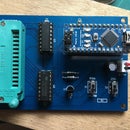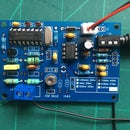Introduction: Re-use LEDC68 Old Gotek Display
I have several Gotek Floppy disk drives all of them have been upgraded to flash floppy, to allow them to be used on retro computers. This software allows for various additions to the standard Gotek drive, notably the 3 digit LED display can be upgraded to OLED displays.
Having done that you get left with lots of 3 digit LED displays, I don't like just disposing of them. And lots of other people seem to have them listed on E-bay and the like. The problem is software support for them seems to be almost non - existent - Until Now.
I modified / wrote a library for the popular Arduino board for this display module. This is how you use it.
Supplies
Your old display from Gotek Drive. Ebay and the like.
Library, Download the project https://github.com/coopzone-dc/GotekLEDC68 as a zip file.
Step 1: Install the Driver Library From GitHub
The first step is to install the library into your Arduino/libraries directory.
Download the project https://github.com/coopzone-dc/GotekLEDC68 as a zip file.
Locate your libraries directory, it's almost always in the folder that your existing projects are saved. Unless you have customised your setup, it will be a folder called Arduino/libraries. For example on my linux laptop it is $HOME/Arduino/libraries. On a Mac OX x it may well be in the Documents/Arduino/libraries folder.
When you have found it, unzip the file into the folder, for example on linux.
cd Arduino/libraries
unzip ../../Downloads/GotekLEDC68-master.zip
On windows you would use "extract to..." and choose your libraries folder.
When it's in place restart the Arduino program to pick up the changes.
Step 2: To Test Your Display Load an Example Programs.
Use the Arduino main menu, File - Examples - Look for "examples from Custom libraries" then find "Gotek-LEDC68-Master"
When it's loaded, you can customise the Pins to use to connect to the display, the defaults are:
#define CLK 3//pins definitions for TM1651 and can be changed to other ports
#define DIO 2
Referring to the picture above, connect the display to the following pins:
Vcc = 5v Power on Arduino
Gnd = Gnd on Arduino
CLK = Digital pin 3 D03 on Arduino
DATA (DIO) = Digital pin 2 D02 on Arduino.
At this point you should be able to compile / upload the sketch and the display will show a count
Step 3: Using the Library With an ESP8266 Node-MCU Clone
Here is a picture of the library demo counter program running on an esp8266 module development kit, it's a cheap version of a nodemcu and works ok.
I have to change the names of this pins to use in the demo counter program from 2,3 to D2,D3 like this:
#define CLK D3//pins definitions for TM1651 and can be changed to other ports
#define DIO D2
You then then connect the display:
pin D2 to CLK
pin D3 to DATA
pin 3V to VCC
pin GND to GND
It seems to work ok at 3.3 volts, BUT keep in mind the datasheet implies 5v operation. In fact I tried this on a stm32 clone and could not get it to work. I suspect the on board 3.3v power supply was not up to it. After all 3 LED displays can draw 160ma when running.
Step 4: Going Further Next Steps
Now you can re-use this useful 3 digit display that would otherwise been sitting in your parts bin! Driving you mad every time you looked at it and thought one day i'll use that....
See the wiki page on Github for further reading, https://github.com/coopzone-dc/GotekLEDC68/wiki
Have fun











